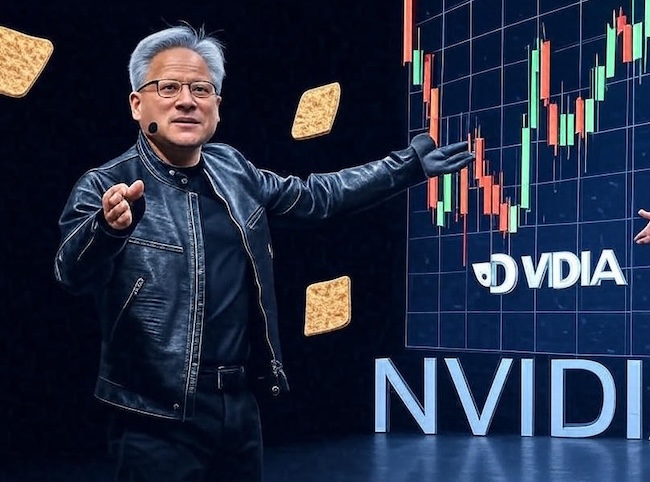Nvidia Goes from $4 Trillion to $5 Trillion in 78 Days
By Reuters | 29 Oct, 2025
The unparalleled rise in the valuation of the world's most valuable company owes to a combination of Jensen Huang's strategy to keep Nvidia central to the AI boom and fortuitous geopolitical tailwinds.
No other company has ever come close to adding $1 trillion dollar in stock valuation in 78 days, and certainly not at the astronomical levels that Nvidia shares have attained. Much of the credit goes to Jensen Huang's skillful positioning of Nvidia's efforts and assets to stay central to the development of AI infrastructure. He has also been equally proactive in seeking navigating the disruptions caused by Trump's erratic moves in the geopolitical arena, especially with respect to China.
Here are the key factors that contributed to Nvidia's trillion-dollar surge as compiled by Gemini:
That is an astonishingly rapid increase in valuation! The key factors that drove Nvidia's market capitalization from $4 trillion to over $5 trillion in just about 78 trading days (approximately three months) are primarily rooted in its unparalleled dominance in the AI infrastructure market and a flurry of high-impact strategic announcements and forecasts.1
Here are the key things that happened:
1. Massive New Orders and Strong Financial Visibility
Projected $500 Billion in Chip Orders: CEO Jensen Huang disclosed that the company expects $500 billion in AI chip orders from its Blackwell and next-generation Vera Rubin platforms over the next five quarters.2 This massive figure signals an unprecedented, long-term demand curve that far exceeds initial analyst expectations.
Continued Explosive Data Center Revenue: Nvidia's financial results continued to show triple-digit year-over-year growth in its Data Center segment—the division responsible for its AI GPUs.3 This segment is the core driver of its current valuation.
Strong Profitability: High operating margins (often above 70%) for its specialized GPUs allow Nvidia to maintain strong pricing power, which gives investors confidence that this rapid growth is also highly profitable and sustainable.4
2. Strategic Partnerships and Government Collaborations
A series of high-profile new partnerships and government deals solidified investor belief in Nvidia's foundational role across multiple future technologies:
OpenAI Investment: A commitment of over $100 billion in computing infrastructure to help OpenAI establish new AI data centers with at least 10 gigawatts of capacity to enhance ChatGPT's computing power.5
Government Supercomputing: A major collaboration with the U.S. Department of Energy to build seven new AI supercomputers for national research, enhancing their leadership in high-performance computing (HPC).6
Telecom Expansion: A $1 billion partnership with Nokia to develop AI-native telecom networks and 6G infrastructure.7
Autonomous Vehicles: A partnership with Uber to develop self-driving robotaxis.8
Enterprise AI: Ongoing collaborations with tech giants like Dell, HPE, and Oracle Cloud to integrate Nvidia's AI platforms into enterprise solutions.9
3. Geopolitical Optimism
Potential Easing of China Export Restrictions: Reports that President Donald Trump planned to discuss the export of Nvidia's Blackwell AI processors with Chinese leader Xi Jinping sparked investor optimism.10 Any easing of U.S. export restrictions on advanced chips to the vast Chinese market could unlock significant, previously restricted revenue.
In essence, the market views Nvidia as the indispensable "picks and shovels" provider of the global AI gold rush.11 The company's rapid jump from $4T to $5T in a short timeframe reflects an acceleration of investor conviction that the AI spending boom is larger, more urgent, and more sustained than previously forecast, with Nvidia holding a near-monopoly on the essential hardware.12

Asian American Success Stories
- The 130 Most Inspiring Asian Americans of All Time
- 12 Most Brilliant Asian Americans
- Greatest Asian American War Heroes
- Asian American Digital Pioneers
- New Asian American Imagemakers
- Asian American Innovators
- The 20 Most Inspiring Asian Sports Stars
- 5 Most Daring Asian Americans
- Surprising Superstars
- TV’s Hottest Asians
- 100 Greatest Asian American Entrepreneurs
- Asian American Wonder Women
- Greatest Asian American Rags-to-Riches Stories
- Notable Asian American Professionals

